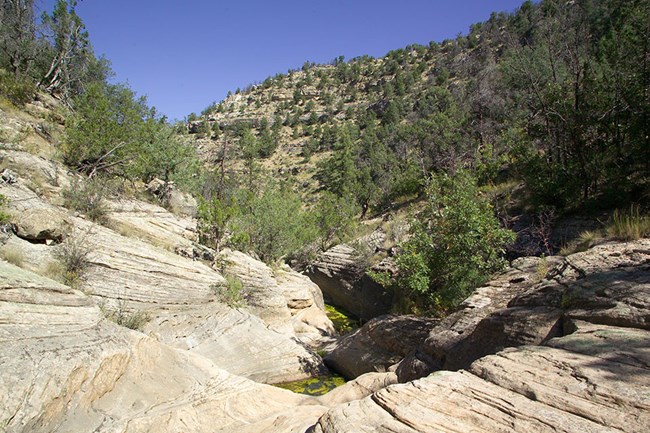
NPS
Walnut Canyon National Monument encompasses 3588 acres (1452 ha) adjacent to the city limits of Flagstaff in north central Arizona. It was established in 1915, to preserve the ruins of Ancestral Puebloan cliff dwellings. The monument was subsequently enlarged several times to fill its current area.
Within Walnut Canyon, ecological communities overlap to form ecotones, bringing together species usually separated by elevation and creating a rare compression of flora/fauna zones. The biodiversity supported by these habitats includes a high concentration of sensitive species and is thought to have contributed to the decision of prehistoric people to settle here. Walnut Canyon contains a narrow stand of broadleaf deciduous forest along the bottom of the canyon and Douglas fir-Gambel oak forest on moist north-facing slopes in the canyon. Drier south-facing canyon slopes support shrubland vegetation, while pinyon-juniper woodland with scattered ponderosa pines and grasslands occupy the areas above the canyon rim.
Four amphibian, 126 avian, 57 mammalian, and 14 reptile species have been documented within the monument. Water resources in Walnut Canyon NM are confined to the narrow canyon bottom through which a stream flows intermittently, fed by springs, seeps, rain, and snow.
Select a Park:
Select a Species Category (optional):
Visit NPSpecies for more comprehensive information and advanced search capability. Have a suggestion or comment on this list? Let us know.
Life Zones
Walnut Canyon NM ranges in elevation from 6,220 to 6,910 feet (1,896–2,106 m) and spans the Semi-Desert Grassland/Shrub Steppe, Pinyon-Juniper Woodland and Ponderosa Pine Forest life zones. Moist north-facing canyon slopes contain microclimates capable of supporting Douglas-fir forest, which is normally associated with the Mixed Conifer Forest life zone. The monument experiences an annual average precipitation of 21.3 inches.

Climate Summary Chart
Charts are an effective way to summarize and graphically represent climate variables. The following chart is based on the diagrams developed for vegetation studies by Walter and Lieth in 1967. Visit our climate page for more information.

Reports & Publications
Inventories are point-in-time surveys that help us learn about the resources in our parks. Information obtained through the Southern Colorado Plateau Network’s inventories of park resources helped to establish a base level of data, which has served as a starting point for our natural resource monitoring.
Source: NPS DataStore Saved Search 3515 (results presented are a subset). To search for additional information, visit the NPS DataStore.
Source: NPS DataStore Saved Search 3471 (results presented are a subset). To search for additional information, visit the NPS DataStore.
Source: NPS DataStore Saved Search 3280 (results presented are a subset). To search for additional information, visit the NPS DataStore.
Last updated: October 21, 2022
